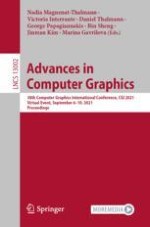2021 | Buch
Advances in Computer Graphics
38th Computer Graphics International Conference, CGI 2021, Virtual Event, September 6–10, 2021, Proceedings
herausgegeben von: Prof. Nadia Magnenat-Thalmann, Victoria Interrante, Daniel Thalmann, Prof. Dr. George Papagiannakis, Assoc. Prof. Bin Sheng, Assoc. Prof. Jinman Kim, Prof. Marina Gavrilova
Verlag: Springer International Publishing
Buchreihe : Lecture Notes in Computer Science
